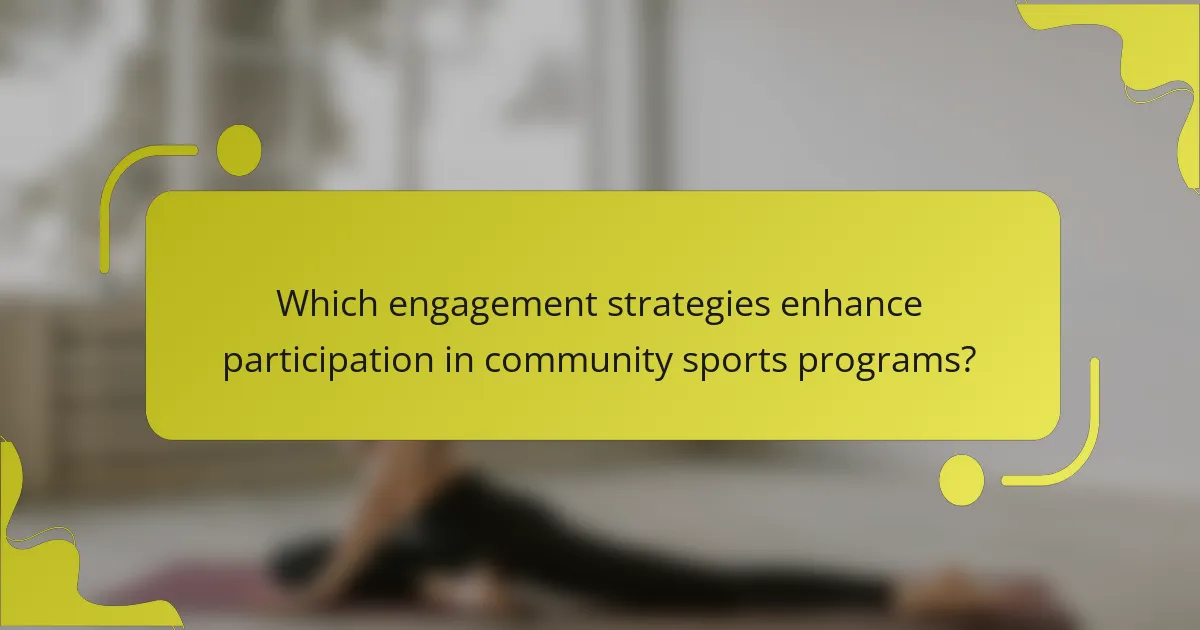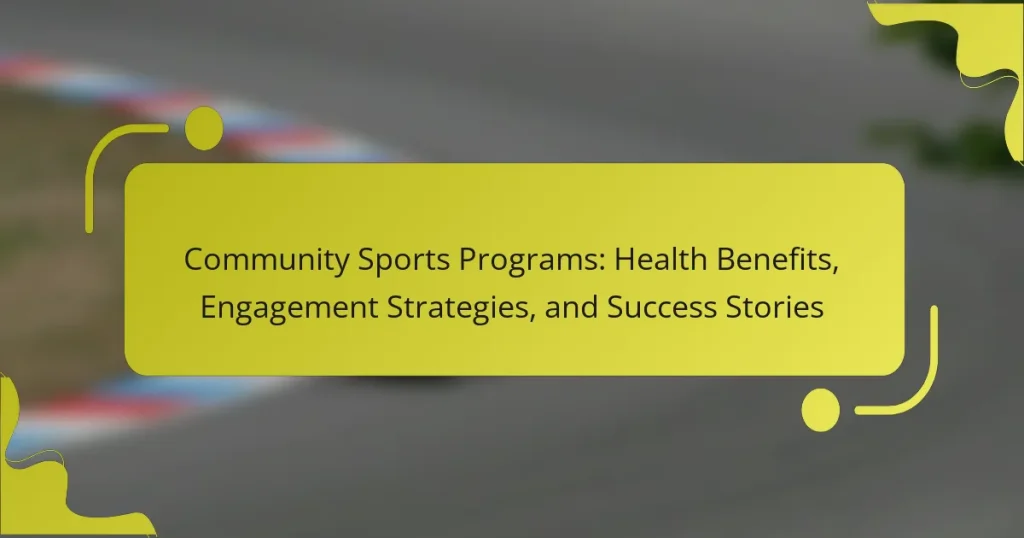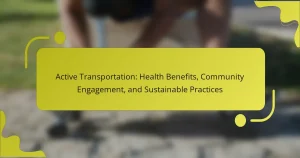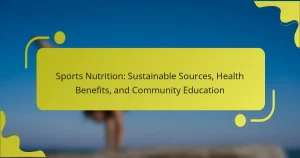Community sports programs offer significant health benefits, including enhanced physical fitness and mental well-being. Effective engagement strategies can increase participation and foster community connections. Success stories highlight the transformative impact of these initiatives, showcasing improved health outcomes and social skills among participants. Funding and resources play a crucial role in ensuring the sustainability and growth of these programs.

What health benefits do community sports programs provide?
Community sports programs provide numerous health benefits, including improved physical fitness, mental well-being, and social connections. Participants often experience enhanced cardiovascular health, increased strength, and better overall endurance. Engaging in these programs can reduce stress and anxiety, fostering a sense of belonging and community. Additionally, regular participation in sports can lead to healthier lifestyle choices, such as balanced nutrition and increased physical activity outside of organized events.
How do community sports programs improve physical health?
Community sports programs significantly enhance physical health by promoting regular exercise, fostering social connections, and improving mental well-being. These programs encourage participants to engage in structured physical activities, leading to increased cardiovascular fitness and overall strength.
Research shows that individuals involved in community sports experience lower obesity rates and reduced risk of chronic diseases. For instance, a study indicated that participants in local sports leagues had a 30% lower risk of developing heart disease.
Additionally, these programs often create a supportive environment, which motivates individuals to maintain an active lifestyle. The social aspect of community sports helps build accountability and encourages long-term commitment to health.
Success stories from various communities highlight the transformative impact of these programs. Participants report improved self-esteem and mental health, showcasing the holistic benefits of engaging in community sports.
What mental health advantages are associated with community sports participation?
Community sports participation offers significant mental health advantages, including reduced anxiety and improved mood. Engaging in team activities fosters a sense of belonging, which enhances emotional well-being. Regular physical activity in these settings can also lead to increased self-esteem and resilience. Studies indicate that participants often report lower levels of depression and stress, highlighting community sports as a vital resource for mental health support.
How do these programs foster social connections and community cohesion?
Community sports programs enhance social connections and community cohesion by bringing individuals together through shared activities. Participants engage in teamwork, fostering friendships and a sense of belonging. These programs often include diverse participants, promoting inclusivity and cultural exchange. As a result, community members develop stronger bonds and a collective identity, which can lead to increased civic engagement and support for local initiatives. Programs also host events that celebrate achievements, further strengthening community ties.

Which engagement strategies enhance participation in community sports programs?
Engagement strategies that enhance participation in community sports programs include targeted outreach, social media promotion, and inclusive events. These strategies foster a sense of belonging and motivate individuals to join. For example, community sports programs can collaborate with local schools to reach youth, creating tailored activities that appeal to diverse interests. Additionally, hosting open houses and free trial sessions can attract newcomers, allowing them to experience the benefits firsthand.
What role do local partnerships play in program success?
Local partnerships are crucial for the success of community sports programs. They enhance resource sharing, increase participation, and foster a sense of belonging. Collaborations with schools, local businesses, and health organizations create a supportive environment that promotes engagement. These partnerships can leverage unique community strengths, such as facilities and volunteers, to maximize program reach and effectiveness. As a result, programs often see improved health outcomes and increased community cohesion.
How can marketing and outreach increase community involvement?
Marketing and outreach significantly enhance community involvement by fostering awareness and participation in community sports programs. Effective strategies include targeted social media campaigns, partnerships with local organizations, and hosting engaging events. These efforts can lead to increased attendance, improved health outcomes, and stronger community ties. For instance, a study showed that communities with active outreach saw a 30% rise in participation rates. Engaging local influencers can also amplify messaging, reaching diverse demographics and encouraging broader involvement.
What innovative formats are being utilized to attract diverse participants?
Community sports programs are utilizing innovative formats like virtual events, hybrid activities, and gamification to attract diverse participants. These formats enhance accessibility and engagement, accommodating various preferences and schedules. For example, virtual fitness challenges allow participants to join from any location, while gamification elements encourage friendly competition and social interaction. Additionally, inclusive programming tailored for different age groups and abilities fosters a sense of belonging. By leveraging technology and creative strategies, community sports programs effectively broaden their reach and enhance participant involvement.

What are some inspiring success stories from community sports programs?
Community sports programs have led to numerous inspiring success stories. These initiatives often enhance physical health, foster teamwork, and build community spirit. For example, a youth soccer program in a low-income neighborhood increased participation by 75%, leading to improved fitness levels and social skills among participants.
Another success story involves a community basketball league that provided mentorship opportunities, resulting in several players receiving college scholarships. Additionally, a local running club improved mental health outcomes for its members, showcasing the psychological benefits of community engagement in sports.
These examples illustrate the profound impact community sports programs can have on individuals and neighborhoods, promoting health and unity.
Which programs have shown significant impact on youth development?
Community sports programs have shown significant impact on youth development by enhancing physical health, social skills, and emotional well-being. Programs like the Positive Coaching Alliance and Up2Us Sports focus on mentorship and teamwork, fostering resilience and leadership. Research indicates that participants in structured sports activities experience improved academic performance and reduced behavioral issues. Additionally, these programs often provide safe environments that encourage youth engagement and community involvement, leading to long-term positive outcomes.
How have community sports initiatives transformed neighborhoods?
Community sports initiatives have positively transformed neighborhoods by enhancing health, fostering engagement, and building community ties. These programs promote physical activity, leading to improved health outcomes such as reduced obesity rates and increased mental well-being.
Moreover, they engage diverse populations through inclusive activities, creating a sense of belonging. Success stories from various neighborhoods highlight how these initiatives have revitalized spaces, reduced crime, and encouraged collaboration among residents. For instance, a program in a struggling area led to a 30% increase in community participation over two years, demonstrating the profound impact of sports on social cohesion.
What lessons can be learned from successful international programs?
Successful international programs demonstrate that community sports initiatives enhance health, foster engagement, and build social connections. Key lessons include prioritising inclusivity, leveraging local resources, and adapting strategies to cultural contexts. For example, programs that incorporate local traditions often see higher participation rates. Additionally, measuring outcomes helps refine approaches, ensuring sustainability and effectiveness. Engaging stakeholders, such as schools and local businesses, strengthens community ties and support for sports initiatives.

How do funding and resources affect the sustainability of community sports programs?
Funding and resources significantly influence the sustainability of community sports programs. Adequate financial support ensures regular operations, maintenance, and growth, while resources like facilities and equipment enhance program quality. Programs with stable funding can offer diverse activities, attracting more participants and fostering community engagement. In contrast, limited resources may lead to reduced offerings and participant dropout. Sustainable community sports programs often rely on a mix of public, private, and sponsorship funding to maintain their activities and reach broader audiences.
What are common funding sources for these programs?
Common funding sources for community sports programs include government grants, private donations, corporate sponsorships, fundraising events, and community partnerships. These sources help sustain and expand program offerings, enhancing community engagement and health benefits.
How can programs effectively manage their budgets?
Programs can effectively manage their budgets by implementing strategic planning and regular monitoring. Establish clear financial goals and allocate resources based on community needs. Utilize cost-effective strategies like partnerships and sponsorships to enhance funding. Regularly review expenditures to ensure alignment with budgetary constraints, adjusting as necessary to maximize impact.
What strategies can be employed to ensure long-term viability?
To ensure long-term viability of community sports programs, focus on sustainable funding, community engagement, and adaptive programming. Establish partnerships with local businesses, schools, and health organizations to secure resources and support. Regularly assess community needs to tailor programs, ensuring they remain relevant and beneficial. Encourage volunteer involvement to build a sense of ownership and commitment among participants. Implement feedback mechanisms to continuously improve offerings based on participant experiences and outcomes.

What challenges do community sports programs face?
Community sports programs face challenges such as funding shortages, volunteer recruitment, and community engagement. Limited financial resources hinder program sustainability, while attracting and retaining volunteers can be difficult. Additionally, fostering consistent participation from community members requires effective outreach and engagement strategies. These obstacles impact the overall success and reach of community sports initiatives.
How do socioeconomic factors influence participation rates?
Socioeconomic factors significantly influence participation rates in community sports programs. Lower-income communities often face barriers such as limited access to facilities, transportation issues, and lack of resources.
Programs that offer free or subsidised activities can increase engagement among underrepresented groups. Additionally, community outreach and tailored marketing strategies help raise awareness and encourage participation.
The success of these programs often correlates with the socioeconomic status of the area, highlighting the need for targeted interventions. For example, a study found that communities with higher income levels have 30% greater participation rates in organized sports.
Addressing socioeconomic disparities can lead to improved health outcomes and increased community cohesion through sports participation.
What barriers exist for marginalized communities in accessing sports programs?
Barriers for marginalized communities in accessing sports programs include financial constraints, lack of transportation, and limited availability of inclusive programs. These factors hinder participation and engagement in community sports. Additionally, social stigma and cultural differences can further isolate these communities from benefiting from sports initiatives. Addressing these barriers requires targeted strategies that promote accessibility and inclusivity.
How can programs adapt to changing community needs?
Programs can adapt to changing community needs by actively engaging with local stakeholders. Regular assessments of community interests and challenges allow programs to adjust offerings. For example, introducing new sports or fitness classes based on demographic shifts can enhance participation. Additionally, utilizing feedback mechanisms ensures programs remain relevant and impactful. Collaboration with local organizations can also provide resources and insights for continual improvement.
What are common pitfalls to avoid in program implementation?
Common pitfalls in program implementation include inadequate planning, lack of community involvement, insufficient resources, and poor communication. Avoiding these issues enhances the effectiveness of community sports programs. Failing to engage local stakeholders can lead to low participation rates. Additionally, underestimating resource needs may hinder program sustainability. Effective communication ensures all parties are informed and aligned, fostering a collaborative environment.
What best practices can enhance the effectiveness of community sports programs?
To enhance the effectiveness of community sports programs, focus on inclusive engagement, strategic partnerships, and continuous feedback. Inclusive programs attract diverse participants, fostering a sense of belonging. Strategic partnerships with local organizations can provide resources and expand outreach. Regular feedback from participants ensures programs evolve to meet community needs, increasing satisfaction and retention.




